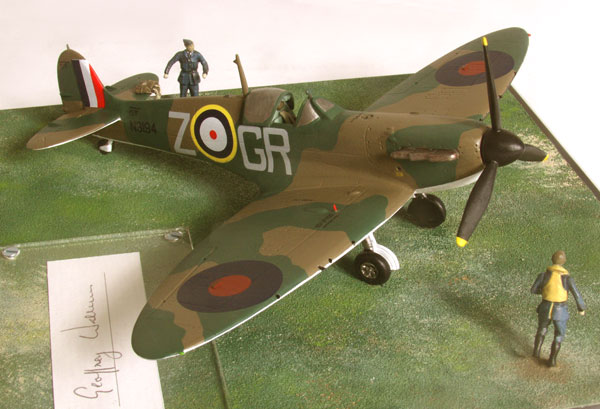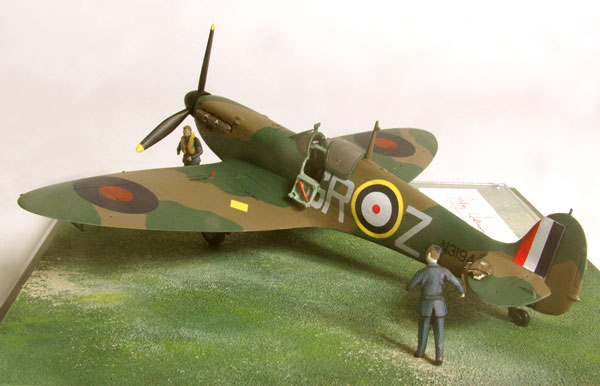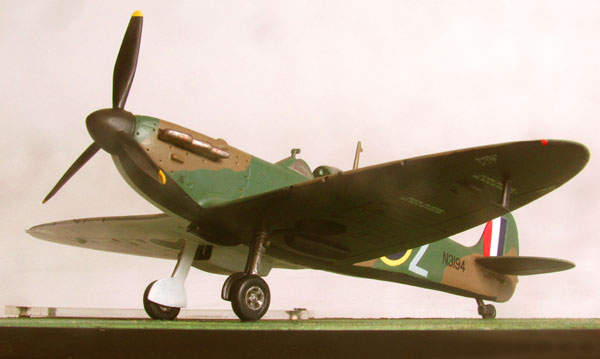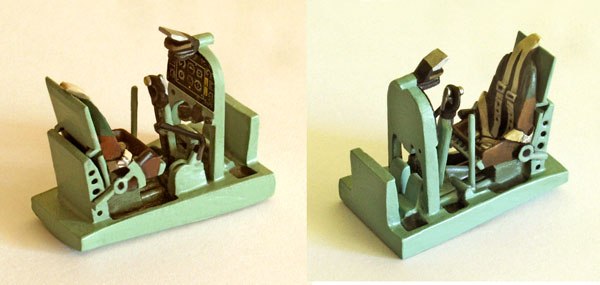Supermarine Spitfire Mk I
Supermarine Spitfire Mk I N3194 GR-Z 92 Squadron,
Sqn Ldr Roger Bushell, RAF Biggin Hill, May 1940.
Spitfire Mk I N3194 was the 435th Spitfire built and was powered by the famous Rolls Royce Merlin III engine. Constructed at Eastleigh N3194 was first flown on the 25th of November 1939 before joining passing through 27MU on the 2nd of December. On the 30th of March 1940 N3194 joined 92 Squadron at Biggin Hill. 92 Squadron was one of the first to receive the new Spitfire Mk I having previously flown Blenheims in 1939. N3194 was given the aircraft letter ‘Z’ and became the aircraft of Squadron Leader Roger Bushell. On the 23rd of May 1940 on a patrol over the channel N3194 and its pilot Sqn Ldr Bushell were shot down by a Messerschmitt Bf109E, N3194 having flown a total of only 46.5 flying hours. Bearing the early war 92 Squadron code of GR, N3194 was painted with a black and white underside to aid in identification of friendly aircraft possibly as a reaction to the famous Battle of Barking Creek incident when a flight of 74 Squadron Spitfires mistakenly attacked Hurricanes from 56 Squadron.
ROGER JOYCE BUSHELL
Born in South Africa on the 30th of August 1910 Roger Bushell was educated at Wellington College, Berkshire before studying at Pembroke College Cambridge where he studied law. Whilst at Cambridge he pursued a passion for athletics and skiing. His skiing led a ‘Black run’ in Switzerland to be named after him, when, at the time he was Britain’s top male skier. He became fluent in French and German which would become useful later in life. In 1932 Roger Bushell joined 601 Squadron Royal Auxiliary Air Force, often referred to as ‘The Millionaires Mob’ because of the wealthy young men who paid their way to learn to fly during training days.
Roger Bushell still pursued his legal career becoming a barrister at law of Lincolns Inn. Bushell was often appointed to military cases involving pilots charged with dangerous flying. Most famously Bushell successfully defended John Freeborn and Paddy Byrne after the friendly fire incident known as the ‘Battle of Barking Creek’ Paddy Byrne was later a POW with Bushell at Stalag Luft III.
In October 1939 Bushell was given command of 92 Squadron his promotion to Squadron Leader being confirmed on January 1st 1940. During the Squadron’s first engagement with the enemy on May 23rd 1940 whilst on patrol near Calais Bushell was credited with two Bf110s of ZG 26 before being shot down, probably by Oberleutnant Gunther Specht. He crash landed on German occupied ground and was taken prisoner before he had the chance to hide. He was sent to the transit camp of Dulag Luft near Frankfurt. Here he was made part of the permanent British staff responsible for the adjustment of Allied aircrew to lift as POWs. Together with Wg Cdr Harry Day and FAA pilot Jimmy Buckley RN he formed the escape committee.
Bushell’s first escape was in May 1941 when he escaped via a tunnel but was recaptured only yards from the Swiss border. He was returned to Dulag Luft with all the other captured escapees and transferred to Stalag Luft I and then Oflag X-C at Lubeck. During his transfer to Oflag VI-B by train, in October 1941 Bushell and several others made their escape and made their way to Prague where they were hidden by the underground movement only to be recaptured after a clampdown by the Germans following the assassination of Reinhard Heydrich in May 1942. After being interrogated by the Gestapo Bushell was sent to Stalag Luft III at Sagan. Here he became head of the escape committee and was known as ‘Big X’. Bushell’s interrogation by the Gestapo had given him an intense hatred for the Nazis and made him determined to strike back however he could. He planned a mass breakout of 200 men on a single night, this became known as ‘The Great Escape’. The plan was to dig three tunnels under the premise that if the guards discovered one tunnel they would not believe another was under way these tunnels were named ‘Tom’, ‘Dick’ and ‘Harry’. 600 prisoners were involved in the construction but eventually in August 1943 ‘Tom’ was discovered. On the evening of the 24th of March 1944 the escape was attempted but things did not go well, of the 200 officers prepared to escape only 76 managed to get clear of the camp. Bushell and Bernard Scheidhauer successfully boarded a train at Sagan but were captured the next day at Saarbrucken waiting for a train to France. Of the original 76 escapees 73 were recaptured, 50 of these men they were taken by the Gestapo and shot on the personal orders of Adolf Hitler. This was a breach of the Geneva Convention and so constituted a war crime.
After the war the perpetrators of this crime were tried and executed, Roger Bushell is buried at the Poznan Old Garrison Cemetery in Poland. He was posthumously Mentioned in Dispatches for his services as a POW in the London Gazette dated the 13th of June 1946.
The aircraft is signed by Geoffrey Wellum who flew with 92 Squadron in the Battle of Britain.
GEOFFREY HARRIS AUGUSTUS WELLUM 42925
Born in Walthamstow, Essex on August 14th 1921, Wellum joined the RAF on a short service commission in August 1939. With training completed he went to 92 Squadron at Northolt on May 21st 1940.
On September 11th Wellum claimed a He 111 destroyed and on the 27th shared in the destruction of a Ju 88. In early August 1941 he was posted away to 52 OTU, Aston Down as an n instructor. He was awarded the DFC (5.8.41), being then credited with at least three enemy aircraft destroyed and several others damaged.
In March 1942 Wellum was posted to 65 Squadron at Debden as a Flight Commander. He was posted to Malta in August and led eight Spitfires off HMS Furious to Luqa. After returning to the UK, Wellum became a test pilot at Gloster Aircraft, testing Typhoons. He later became a gunnery instructor, continuing this duty until the end of the war.
Wellum retired from the RAF on June 30th 1961, as a Flight Lieutenant, retaining the rank of Squadron Leader. APO 23.10.39 PO 20.5.40 FO 20.5.41 FL 20.5.42 FL 1.9.45
Ref: Men of the Battle of Britain by Kenneth G. Wynn (CCB Publications)
Scale 1:48 Wingspan 9.2″ (234 mm)
Base size 9.33″ (237 mm) square (No. 6)
Weight not including base 1lb 4.25 ozs (578 grams) Limited edition of 25 only
SOLD OUT





